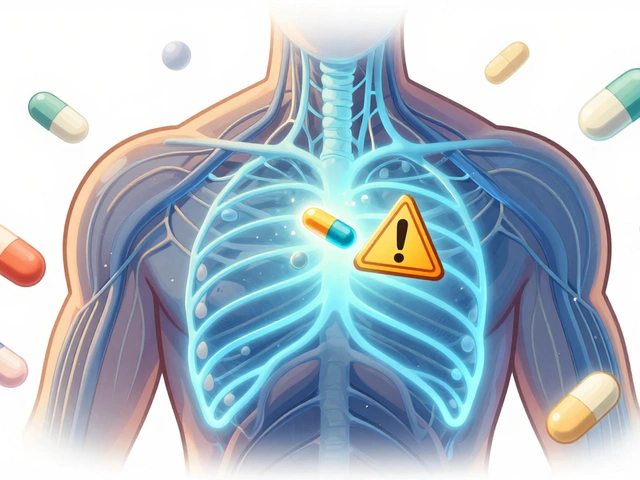
PTSD Symptom Tracker
Track your daily mindfulness practice and monitor changes in PTSD symptoms over time.
History
| Date | Duration | Type | Anxiety Before | Anxiety After | Change |
|---|
Quick Takeaways
- Mindfulness and meditation can lower trauma‑related anxiety by up to 30% in just six weeks.
- Start with 5‑minute breath‑focus sessions and gradually add body‑scan or loving‑kindness practices.
- Combine mindfulness with therapy or medication for the best long‑term results.
- Grounding techniques help stop flashbacks in the moment.
- Track progress in a simple journal to keep motivation high.
Living with Posttraumatic Stress Disorder is a daily battle against intrusive memories, hyper‑vigilance, and emotional numbness. While medication and psychotherapy remain mainstays, a growing body of research shows that mindfulness a mental practice of paying attention to the present moment without judgment and meditation structured techniques that train attention and awareness can calm the nervous system and reshape brain pathways that keep trauma stuck.
What Is PTSD and Why It Feels So Overwhelming
PTSD develops after a traumatic event-combat, assault, accidents, or natural disasters-when the brain struggles to store the memory safely. The amygdala the brain’s alarm center that flags danger stays hyper‑active, while the prefrontal cortex responsible for rational decision‑making loses its grip. The result? Nightmares, flashbacks, and a constant readiness for threat.
Stress hormones like cortisol a hormone released during stress that influences memory and mood can become dysregulated, making it harder to calm down after a trigger. Over time, the brain’s plasticity-its ability to rewire-gets locked into a fear‑based pattern.
How Mindfulness Re‑boots the Brain
Mindfulness works by training the brain to observe thoughts and sensations without instantly reacting. Functional MRI studies from 2023 show that an eight‑week mindfulness‑based stress reduction (MBSR) program reduces amygdala activity by 15% and boosts the prefrontal cortex’s regulatory power.
On a cellular level, regular practice promotes neuroplasticity the brain’s ability to form new connections and weaken old, maladaptive ones. This means the neural pathways that trigger flashbacks can be weakened while healthier, calm‑focused circuits grow stronger.
Getting Started: Simple Meditation Practices for PTSD
Begin with just five minutes a day. Consistency matters more than length. Below are three evidence‑based practices that have shown the most benefit for trauma survivors.
- Breath Awareness
Sit comfortably, close your eyes, and bring attention to the inhale‑exhale cycle. Count silently “one” on the first inhalation, “two” on the exhale, and continue up to ten before starting over. When thoughts drift-especially trauma‑related ones-label them “thinking” and gently return to the breath.
- Body Scan
Lie on your back or sit upright. Starting at the toes, slowly move your focus upward, noticing any tension, temperature, or tingling. If you encounter a painful memory, acknowledge the sensation without judgment and keep scanning. This practice helps ground the nervous system and reduces hyper‑arousal.
- Loving‑Kindness (Metta) Meditation
After you feel stable with breath work, try sending goodwill to yourself and others. Silently repeat: “May I be safe, may I be calm, may I be free from fear.” Then expand the wish to a loved one, a neutral person, and even a difficult person. Research from the VA in 2022 linked Metta meditation to lower depressive symptoms in veterans with PTSD.

Grounding Techniques to Stop Flashbacks in Their Tracks
When a flashback spikes, shifting attention back to the present can break the cycle. Grounding technique any sensory exercise that anchors you to the here‑and‑now works like an emergency brake.
- 5‑4‑3‑2‑1 Method: Name five things you can see, four you can touch, three you can hear, two you can smell, and one you can taste.
- Cold Water Splash: Splash your face with cold water or hold an ice cube for 30 seconds.
- Physical Movement: Do ten jumping‑jacks or stomp your feet to generate proprioceptive feedback.
Practice these grounding steps during calm moments so they become automatic when you need them.
Integrating Mindfulness with Traditional PTSD Treatment
Mindfulness isn’t a replacement for therapy or medication; it’s a complement that can boost their effectiveness. Below is a quick comparison of three common approaches.
| Aspect | Mindfulness & Meditation | Medication (e.g., SSRIs) | Psychotherapy (e.g., CBT, EMDR) |
|---|---|---|---|
| Onset of benefit | 2-6 weeks with regular practice | 4-8 weeks for full effect | 6-12 weeks depending on modality |
| Side‑effects | Minimal, may include temporary emotional discomfort | Weight gain, sexual dysfunction, sleep issues | None physical, emotional fatigue possible |
| Long‑term relapse risk | Low when practice is sustained | Higher if medication stopped abruptly | Low if skills are internalized |
| Core focus | Present‑moment awareness, self‑compassion | Neurochemical regulation | Cognitive restructuring, trauma processing |
Many veterans and survivors report that adding a 20‑minute mindfulness routine to weekly Cognitive Behavioral Therapy a structured talk therapy that challenges unhelpful thoughts yields quicker symptom relief.
Common Pitfalls and Pro Tips
Even a well‑intentioned practice can backfire if you overlook these traps.
- Expecting instant peace. Mindfulness uncovers suppressed emotions; feeling upset at first is normal.
- Skipping the body. Trauma lives in the somatic system. Ignoring bodily sensations delays healing.
- Practicing in isolation. Join a group or use guided apps that specialize in trauma‑sensitive meditation.
- Neglecting professional support. If flashbacks intensify, reach out to a therapist right away.
- Inconsistent schedule. Set a daily alarm; even three minutes beats sporadic hour‑long sessions.
Remember, the goal isn’t to erase the past but to change how your brain and body respond to it.
Next Steps and Tracking Your Progress
Set up a simple log:
- Write the date and time of each practice.
- Note duration (e.g., 5min breath, 10min body scan).
- Rate anxiety level before and after on a 0‑10 scale.
- Record any intrusive thoughts or triggers that appeared.
Review the log weekly. Patterns will show you which techniques lower your scores the most, letting you fine‑tune your routine.
Frequently Asked Questions
Can mindfulness replace medication for PTSD?
Mindfulness is a powerful supplement but rarely a standalone cure. Medication targets neurochemical imbalances, while mindfulness reshapes attention and stress responses. Most clinicians recommend a combined approach for best outcomes.
How long before I notice a reduction in flashbacks?
Studies show measurable decreases in flashback frequency after 4-6 weeks of daily practice, though individual timelines vary. Consistency beats intensity.
Is it safe to meditate if I have severe anxiety?
Yes, but start with short, guided sessions that emphasize safety. Trauma‑informed programs often include “observer” language to prevent overwhelming experiences.
Do I need any special equipment?
Nothing beyond a quiet spot and a comfortable seat. A yoga mat can help for body‑scan or floor‑based practice, and a timer or phone app keeps the session on track.
What’s the best time of day to practice?
Morning sessions set a calm tone for the day, while evening practice can ease bedtime anxiety. Experiment and stick with the slot that feels most sustainable.






17 Comments
While the article does a decent job summarizing common mindfulness techniques, it overlooks the neurochemical specifics that actually drive the reduction in amygdala activity. The cited 30% drop in anxiety is likely a product of selection bias in the studies referenced. Moreover, the suggested duration of five minutes per day ignores the dose‑response curve documented in recent fMRI trials. In short, the piece feels more like a promotional flyer than a critical appraisal.
Hey folks! I’ve been digging into the hidden side of mindfulness apps and noticed they’re secretly funded by big pharma to keep us hooked on their supplements. No wonder they push “quick fixes” – it’s a subtle way to keep the market churn alive. Stay vigilant and don’t let anyone tell you it’s all harmless!
🌱 Mindfulness, at its core, is an invitation to witness the flow of consciousness without the burden of narrative labels. When we detach from the story‑telling mind, we create space for the soul’s quiet whisper to be heard. It’s less about “technique” and more about a cultural shift towards presence. 🕉️
I’ve tried the 5‑minute breath work and felt a tiny dip in my panic meter.
Your enthusiasm is clear, but the claim about pharmaceutical funding lacks credible sources and could mislead readers. It would be helpful to reference specific studies before drawing such conclusions.
Look, the article pretends to be science based but it’s really just a rehash of mainstream self‑help fluff that the western wellness industry pumps out daily. It ignores the fact that many of the so‑called “mindfulness” programs were extracted from Eastern traditions and then stripped of their cultural context for profit. If you’re serious about healing, stop buying into these watered‑down versions that cater to a consumer base that wants quick fixes. The data they quote is cherry‑picked, the language is vague and the whole thing feels like a marketing brochure for a wellness empire. We need real evidence, not anecdotes dressed up as research, and we need to stop letting corporations dictate our mental health strategies. It’s time to demand transparency and authenticity, not just another product launch.
While the piece offers a helpful overview, it could benefit from a clearer structure that separates evidence from anecdote; readers often need to discern where the science ends and personal testimony begins. Including a brief discussion of potential contraindications would also respect those who might experience heightened anxiety during early meditation attempts. A simple table summarizing the time commitment versus expected anxiety reduction could make the information more accessible. Overall, the intent is commendable and the content is valuable, yet a few organizational tweaks would enhance its practical utility.
Interesting breakdown; I’ll try the 5‑minute breath focus tomorrow.
Great plan! Starting small makes the habit stick and you’ll likely notice a calmer mindset throughout the day.
Your suggestion about the 5‑minute start is solid but remember to keep the posture upright; slouching can actually increase tension and counteract the relaxation response. Also, if you find your mind wandering to stressful thoughts, gently bring it back without judging yourself-that’s the core of cognitive re‑appraisal. Keep a log as the article advises; data beats vague feelings any day.
👍 Keep at it! Consistency is the secret sauce, and you’ll start seeing those anxiety numbers drop week by week. Remember to celebrate the tiny wins-they add up! 😊
Ah, the classic hype‑cycle of mindfulness: sprinkle a few buzzwords like ‘neuroplasticity’ and ‘prefrontal regulation’ and suddenly we’ve engineered a miracle cure. Sure, the cortical activation maps look pretty, but let’s not pretend a five‑minute body scan will rewrite years of trauma‑induced circuitry without adjunctive therapy. It’s all very nice on a PowerPoint, but the real world isn’t a sandbox of idealized outcomes.
Indeed-while the terminology sounds impressive, the empirical support remains limited; therefore, practitioners should exercise caution, especially when recommending these protocols to patients with severe PTSD.
Mindfulness is a global practice rooted in centuries‑old traditions; respecting its origins while adapting techniques can bridge cultural gaps and enhance therapeutic outcomes.
Don’t let the hype scare you-simplicity beats complexity every time; a few mindful breaths beats a whole symposium of scientific jargon when you just need calm.
In the theater of the mind, trauma drapes a heavy curtain that obscures the stage of ordinary perception.
Mindfulness steps onto that dimly lit arena as a gentle spotlight, coaxing the actor of anxiety into a quieter cadence.
When we breathe with intention, each inhalation becomes a brushstroke painting a temporary sanctuary on the canvas of consciousness.
The brain's amygdala, that vigilant sentinel, learns to lower its alarm when it is repeatedly shown that the storm has passed.
Neuroplasticity, the brain's own sculptor, reshapes the hardened pathways of flashbacks into softer, more pliable routes.
Such transformation does not happen in a single breath; it is a mosaic built from countless mindful moments.
Grounding techniques, like the 5‑4‑3‑2‑1 method, act as anchor chains that tether the wandering soul back to the present dock.
Loving‑kindness meditation fans the ember of compassion, turning self‑criticism into a warm, forgiving glow.
Even the simplest body scan can dissolve tension that lurks like hidden knots beneath the surface of muscles.
Consistency is the master alchemist that converts these modest practices into lasting internal alchemy.
Yet, the journey demands patience, for the mind is a stubborn garden that resists trimming without careful coaxing.
Integrating mindfulness with professional therapy is akin to weaving two sturdy threads into a resilient rope.
When the rope is pulled, it bears the weight of trauma without snapping, allowing the survivor to walk forward.
Remember, the aim is not to eradicate the past but to rewrite its narrative tone from a scream to a whisper.
Each session, no matter how brief, plants a seed of serenity that, with nurture, blossoms into a forest of calm.
So sit, breathe, observe, and let the symphony of present moment gradually dissolve the discord of yesterday.
While the guide hits the main points, a few editorial tweaks could raise its credibility; for instance, citing the specific journal articles behind the 30% anxiety reduction would satisfy the more skeptical readers. Also, a brief disclaimer about the possibility of increased anxiety during early meditation sessions would show responsible care. Finally, adding a printable version of the tracker table could improve accessibility for users who prefer paper logs.